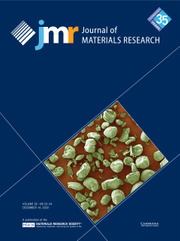Article contents
SrAl12O19:Pr3+ nanodisks and nanoplates: New processing technique and photon cascade emission
Published online by Cambridge University Press: 31 January 2011
Abstract
High-quality SrAl12O19:Pr3+ nanodisks and nanoplates were fabricated via a new processing technique based on a modified polymer steric entrapment method. Serious agglomeration and large particle size distribution of final products, which usually occurred in the conventional method, were eliminated completely. The effects of new synthetic processes on the morphology, crystallization, and yield of products and the relevant mechanisms were discussed. As far as we know, SrAl12O19:Pr3+ nanodisks with mean diameter ∼60 nm and thickness between 5 and 10 nm were successfully synthesized for the first time by this low-cost technique. The new synthetic method may provide a general route to synthesize other refractory mixed-oxide nanocrystals. Photon cascade emission involving transitions 1S0–1I6 followed by 3P0–3H4 in SrAl12O19:1% Pr3+ nanodisks was investigated. Size-effect-induced blue shift of the 4f5d states of Pr3+ was observed in SrAl12O19:1% Pr3+ nanodisks, in which the quantum efficiency was preserved, as in the bulk counterparts.
Keywords
Information
- Type
- Articles
- Information
- Copyright
- Copyright © Materials Research Society 2009
References
REFERENCES
- 2
- Cited by

